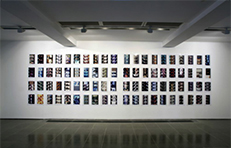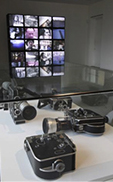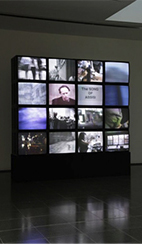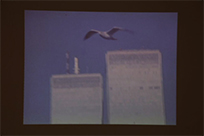Jonas Mekas
Serpentine Gallery, London, 5 December 2012–27 January 2013Laura Busetta
Jonas Mekas turned ninety on 25 December 2012, and the sixty-year career of the Lithuanian-born artist, poet and filmmaker has been at the centre of several events, talks, screenings and exhibitions organised in London and Paris. The Centre Pompidou in Paris and the BFI Southbank in London both presented screenings of Mekas’s older and recent works, and the London Serpentine Gallery programmed a series of seminars and films, coinciding with a central solo show on the life and work of the filmmaker. The Serpentine Gallery presents different elements of the filmmaker’s personal story—such as photographs, printed stills, videos, writing, documents, a selection of poems translated from the Lithuanian, a display of Bolex cameras and even a copy of Mekas’s passport—which are put together in an extensive collage. Entering the first room, the visitor suddenly faces what we can describe as a visual representation of the double identity of the filmmaker. Displayed on the wall is a series of eighty photographic prints, each made up of three 16mm frames extracted from the world premiere of Mekas’s new feature-length film, Outtakes From The Life of a Happy Man (2012), which forms the heart of the exhibition. The installation is titled My Two Families, and is divided into two groups: on the left there is a selection of portraits of Mekas’s family, and on the right several images of his collaborators, friends and acquaintances: “family one is my home family: Hollis, Dana, Sebastian; family two is my friends in film”, as it is written in the description of the installation. The photographs portray famous artists and popular personalities, such as Andy Warhol, Pier Paolo Pasolini, Allen Ginsberg, Lou Reed, Edie Sedgwick, Salvador Dalì, P. Adam Sitney and Hollis Frampton. The two families are therefore together representative of the two hemispheres that constitute the filmmaker’s affective universe. It is a visual representation of that particular identity which is characteristic of the displaced person, always split between native and adopted homeland.
Figure 1: My Two Families (2012)
Photographic prints of 16mm film frames 43.2 x 27.9 cm
Installation view, Jonas Mekas, Serpentine Gallery, London © 2012 Jerry Hardman-Jones
Those who are familiar with the work of Jonas Mekas are indeed aware that exile and displacement are the main themes that recur throughout his entire filmic production. Mekas left his native Lithuania in 1944 because of the war and arrived in New York in 1949, after having spent some years in a displacement camp in Germany with his younger brother Adolph. Having lost both his family and homeland, the never-ending effort of the filmmaker has always been the construction of another place he could finally call home. After arriving in America, Mekas bought his first Bolex camera in 1950, and began to film the ordinary life of Lithuanian immigrants in Williamsburg. Those shots are included in the Serpentine exhibition in a series titled Images from Purgatorio, referring to the fact that the previous experience in the displaced person camps was a sort of hell. The prints provide an insight into the life of the immigrant community of the time, always looking from the other side of the river at the New World, so close and yet inaccessible like a mirage. For all of them, as for Mekas himself, There Is No Ithaca, as indicated in the title of the filmmaker’s collection of poems exposed at the Serpentine. There is a pervasive sense of nostalgia that runs through his work and that is also palpable in the exhibition.
Figure 2: Jonas Mekas, There Is No Ithaca (Black Thistle Press, 1996)
Photograph: Jonas Mekas © 2012 Jerry Hardman-Jones
Mekas has always filmed everything that surrounded him, in order to create new memory images capable of replacing the lost reminiscences. The necessity of filming his own life and experiences has always compensated for the filmmaker’s lack of a home, and his detachment from memory images. It has been defined as an accented cinema—far removed from the dominant circuits of cinema (considered universal and without any accent)—in which the concept of exile and diaspora is particularly relevant (Naficy). The particular accent in Mekas’s work is a consequence of the condition of the dislocation of the filmmaker and emerges in its mode of production. Mekas’s filmography is particularly personal, and he is at the same time producer, director, actor, editor, narrator and distributor. The filmmaker is often referred to as the godfather of the New American Cinema, but despite his venerable age and his conspicuous corpus of work, there is still a sense of freshness and a feeling of discovery that transpires in his images. This freshness is somehow intrinsic to the aesthetic practice of the American avant-garde, and the show certainly has a sense of spontaneity in the way it exhibits poetry and images simply printed on paper and attached to the wall with clear tape, reflecting somehow the simple, extemporaneous, and anticommercial nature of Mekas’s production. Since the 1960s, along with the other protagonists of New American Cinema—including Stan Brakhage and Maya Deren—Jonas Mekas has developed an intimate filmic look, using amateur practices in order to differ from the established paradigm of Hollywood production. This is documented by shots and videos depicting some of the most legendary protagonists of the New York artistic scene of the 1960s, which shows the germination of the New American Underground. The video diaries seem to revive a lost memory, and record the evolution of a new group, or the Birth of a Nation (1997), as Mekas titled the four-channel video portrait he made of the generation of musicians, poets and artists who created underground cinema in the U.S. If his primary home is lost, the methods of home movies, as well as the associative nature of the American underground cinema and the foundation of the Anthology Film Archive in 1969, allow the filmmaker in exile to build a new family. Mekas has continuously recorded his experiences with his Bolex, reediting them to build his fragmentary narratives.
Figure 3: Bolex cameras owned by Mekas
Installation view, Jonas Mekas, Serpentine Gallery, London © 2012 Jonas Mekas
Originally, he intended his footage as exercises, or preparatory notes for a film to be made; as we read in “The Diary Film”:
I take what I can, from desperation. But for a long time I didn’t look at the footage I was collecting that way. I thought what I was actually doing was practising. I was preparing myself, or trying to keep in touch with my camera, so that when the day would come when I’ll have time, then I would make a “real” film. (Mekas, “The Diary Film” 190)
Mekas’s films are perhaps considered the best example of diaristic cinema, which he explored along his entire career. His long project Diaries, Notes and Sketches documents his experience in America from 1949 to 1984, and is composed of seven films: Diaries, Notes and Sketches: Walden (1969), Reminiscences of a Journey to Lithuania (1972), Lost Lost Lost (1975), In Between (1978), Notes for Jerome (1978), Paradise Not Yet Lost (1979), He Stands in a Desert Counting the Seconds of His Life (1984). The diary structure also distinguishes his most recent works, such as 365 Day Project, a set of video diaries made every day throughout 2007, available online in a section of his frequently updated website, jonasmekasfilms.com.
All the objects displayed—such as the filmmaker’s technical equipment, notes, poems, sheets and the Anthology Film Archive banner designed in 1970 for the Archive’s opening that resembles the flag of a new country—and all the heterogeneous materials shown are evidence of a particular memory: traces of a life. An installation of a set of sixteen monitors titled Lavender Piece (2012) simultaneously displays all Mekas’s different 16mm films. Views of streets, snow, people, portraits of the filmmaker are mixed without a narrative theme or a chronological order, evoking an instantaneous self-portrait of the artist, composed of glimpses selected by his gaze, rather than images of his body.The flow of images and sounds comprise the exhibition and somehow become indistinguishable, forming fragments of an entire, unique project.
Figure 4: Lavender Piece (2012)
16mm film transferred to video, various dates, each film 5–15min
Installation view, Jonas Mekas, Serpentine Gallery, London © 2012 Jerry Hardman-Jones
Catherine Russell defines Jonas Mekas’s diary films as the prototypical autoethnographies, “as they mark a kind of penultimate romanticism that has long been eclipsed in postmodernism” (Russell 281), an autoethnographic journey in which personal history is implicated in larger social formations and historical processes. The author should not be considered as the hero of his own life but as an empirical subject located in between different cultures, social formations and cinematic practices. Like Ulysses, Mekas sings his life travels, mixing the moment of direct experience with that of the recording, and editing the shots in a way that gives testimony to the passage of time: “the temporal gap between the collection and the editing of images into films many years later renders every image a memory, a trace or fragment of a time. … The autoethnographic subject becomes a stranger in a strange land, even if that land is a fictional space existing only in representation”. (Russell 280). The frames of his films are intimately linked to the places where they were made. Place gives testimony to the passage of time, as happens in the film WTC Haikus (2010), a homage to the World Trade Centre projected on a wall of the Serpentine. The film is constituted by the juxtaposition of several glimpses of the Twin Towers, shot between 1973 and 2010, from near and far, out of focus, or as shadows on the floor, surrounded by birds flying around them or immersed in the fog as in a delicate premonition accompanied by a simple music played by a piano.
Figures 5 and 6: WTC Haikus (2010)
16mm film transferred to video, 14min 4sec
Installation view, Jonas Mekas, Serpentine Gallery, London © 2012 Jerry Hardman-Jones
Mekas’s subjective space is crossed by social and cultural phenomena, in which personal cinema opens up to a universal and historical representation. The videos build a story in which the chronology is substituted by a topological order, and the subject is dispersed between the traces of his travels. The author of this autobiographical footage should be considered as an empirical subject, located in between different cultures, different social formations and cinematic practices. Despite the autobiographical coefficient of the image and elements screened, this assemblage is not to be intended as a desire to tell the truth about a man, the images themselves being just fragments or glimpses of a life. Mekas has spent his entire life filming, and little by little the images he filmed became his own recollections. Cinema is the only art which, to use Jean Cocteau’s expression, films death at work; it evokes the mechanism of time. “The image are not memories”, as the tired voiceover of Outtakes from the Life of a Happy Man pronounces: “memories are gone but the images are here and they are real, right there in front of your eyes”. The formal characteristics, as well as the visual style, narrative construction and modes of production of his filmography build together a form of exilic filmmaking; his works seem to reflect the composition of his fragmented biography. In this sense the Serpentine exhibition is also a reflection on amateur practices, diaristic cinema, practices of self-representation and the notion of identity. We are presented with a brief condensation of self-representational practices, and a consideration of the particular personality of the displaced person, always split between origin and adopted homelands. The concept of identity continuously tries to escape from identification, and the result of the combination of elements in the exhibition is not the recomposition of a story but the reproduction of a rhythm. The viewer has the opportunity to take a journey into the filmmaker’s life and work, through the vast amount of images in which he is inscribed as a survivor of his own past. Hybrid identities can be better represented through fragmentary practices, and fragmentation is rightly the privileged aesthetic form emerging at the Serpentine exhibition. This is probably the reason why the work of Jonas Mekas fits well in a gallery space. Pieces of memory and traces of life are collected together, revealing a fragmented, divided personality. There is neither a set narrative nor an obligatory way to interpret it. You can follow different routes; you can take your time to enter the paths of subjectivity.
References
1. Mekas, Jonas, dir. Birth of a Nation. 1997. Film.
2. ---, dir. He Stands in the Desert Counting the Seconds of His Life. 1986. Film.
3. ---, dir. In Between. 1978. Film.
4. ---. Lavender Piece. 2012. Installation.16mm film transferred to video.
5. ---, dir. Lost, Lost, Lost. 1976. Film.
6. ---. My Two Families. 2012. Installation. Photographic prints of 16mm film frames.
7. ---, dir. Notes for Jerome. 1978. Film.
8. ---, dir. Outtakes from the Life of a Happy Man. 2012. Film.
9. ---, dir. Paradise Not Yet Lost. 1980. Film.
10. ---, dir. Reminiscences of a Journey to Lithuania. 1972. Film.
11. ---. “The Diary Film. A Lecture on Reminiscences of a Journey to Lithuania” (1972). The Avant-Garde Film: A Reader of Theory and Criticism. Ed. P. Adams Sitney. New York: New York UP, 1978. 190–8. Print.
12. ---, dir. Walden/Diaries, Notes and Sketches. 1969. Film.
13. ---, dir. WTC Haikus. 2010. 16mm film transferred to video.
14. Naficy, Hamid. An Accented Cinema: Exilic and Diasporic Filmmaking. Princeton and Oxford: Princeton UP. 2001.
15. Russell, Catherine. Experimental Ethnography: The Work of Film in the Age of Video. Durham: Duke University Press, 1999. Print.
Suggested Citation
Busetta, L. (2013) Jonas Mekas, Serpentine Gallery, London, 5 December 2012-27 January 2013. Alphaville: Journal of Film and Screen Media, 5, pp. 162–168. https://doi.org/10.33178/alpha.5.12.
Laura Busetta completed her PhD in Film Studies at Sapienza University of Rome in 2013 with a thesis entitled “The Self-portrait Film”. Her publications include articles on the cinema of Orson Welles, Jean-Luc Godard, Marco Ferreri, and Ciprì and Maresco. She has published in academic journals such as Imago, Fata Morgana, Cineforum, Alfabeta2 and she is now pursuing research on self-representation in digital film and media.















